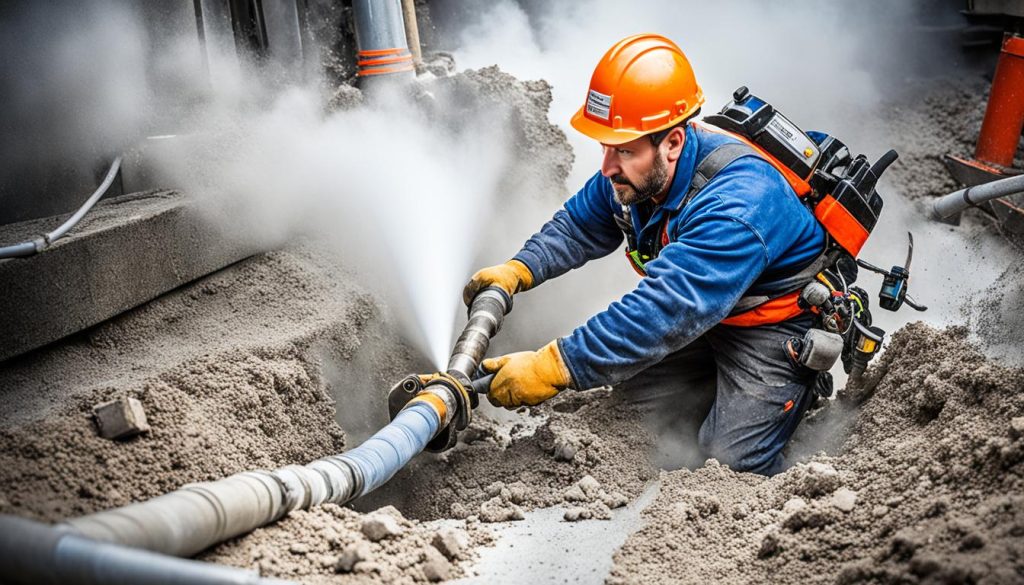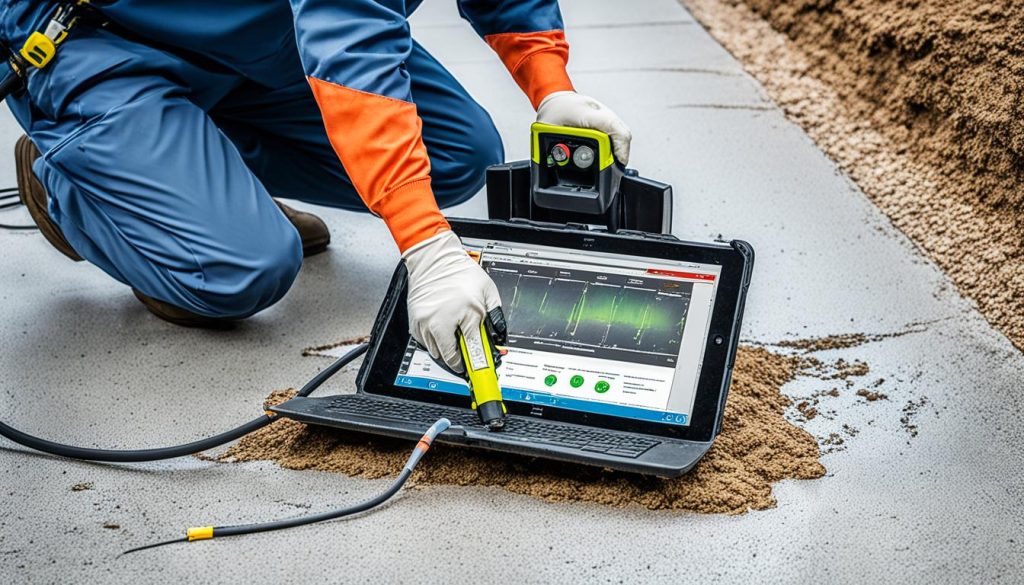Slab Foundation Plumbing Insights & Tips
Did you know that plumbing in a slab foundation can be a challenging task? With the plumbing pipes embedded in the concrete, repairs and maintenance can be a time-consuming and costly affair.
Slab foundations are a popular choice due to their affordability and quick drying time. However, they come with their share of difficulties when it comes to plumbing. In this article, I will provide you with valuable insights and tips on slab foundation plumbing, from the common problems you may encounter to detecting and repairing slab leaks.
Key Takeaways:
- Plumbing in a slab foundation can be challenging due to the pipes being embedded in the concrete.
- Common problems with slab foundations include cracking, settling, and upheaval.
- Accessing the plumbing for repairs in a slab foundation requires cutting through the concrete.
- Slab leaks can be detected through signs such as high water bills and the presence of mold.
- Preventing slab leaks involves regular inspection, managing water pressure, and maintaining the soil around the foundation.
Common Problems with Slab Foundations
Slab foundations are a popular choice due to their affordability and ease of construction. However, they are not without their share of issues. Here are some common problems that can arise with slab foundations:
Cracking
One of the most prevalent problems with slab foundations is cracking. Cracks can occur for various reasons, including:
- Freezing temperatures: Extreme cold can cause the concrete to contract, leading to cracks.
- Shifting soil: If the soil beneath the foundation moves, it can cause the concrete to crack.
- Tree roots: As tree roots grow, they can exert pressure on the foundation, resulting in cracks.
- Natural disasters: Earthquakes or flooding can put immense stress on the foundation, causing cracks to form.
Settling
Another issue commonly encountered in slab foundations is settling. When the soil beneath the foundation compresses or shifts, it can lead to various problems, such as:
- Instability: Settling can make the foundation unstable, posing a risk to the structural integrity of the building.
- Sagging ceilings: Uneven settling can cause ceilings to sag, creating aesthetic concerns and potential safety hazards.
- Bowed walls: Settling can cause walls to bow inward or outward, indicating significant foundational issues.
- Cracks: As the foundation settles, cracks may form in the concrete, requiring immediate attention.
Upheaval
Upheaval is another problem that can occur in slab foundations. This phenomenon happens when moisture beneath the foundation freezes and expands, causing the foundation to rise. Upheaval can result in:
- Uneven floors: As the foundation lifts in certain areas, it can lead to noticeable unevenness in the floors.
- Cracks in walls: Upheaval can cause sheetrock or plaster walls to crack, indicating potential foundation movement.
- Disrupted plumbing: The shifting of the foundation during upheaval can damage plumbing pipes, leading to leaks and water-related issues.
These common problems with slab foundations should not be ignored. Taking prompt action to address and resolve these issues is crucial to preserving the integrity of your home or building.
| Problem | Cause | Effects |
|---|---|---|
| Cracking | Freezing temperatures, shifting soil, tree roots, natural disasters | Potential structural damage, water infiltration |
| Settling | Compressed or shifting soil | Instability, sagging ceilings, bowed walls, cracks |
| Upheaval | Freezing moisture beneath the foundation | Uneven floors, cracks in walls, disrupted plumbing |
Challenges of Plumbing in a Slab Foundation
When it comes to plumbing in a slab foundation, there are unique challenges that homeowners and plumbers face. One of the main challenges is the need to cut through the concrete in order to access the plumbing for repairs. This process can be both time-consuming and expensive, requiring specialized tools and skills. Additionally, the limited space within a slab foundation makes it difficult to run gas and water lines, which are typically embedded in the foundation during construction.
The difficulty in accessing the plumbing in a slab foundation adds to the complexity of repairs. Unlike traditional foundations where pipes are easily accessible through basements or crawl spaces, finding and fixing plumbing issues in a slab foundation requires careful planning and execution. Plumbers may need to remove sections of flooring or walls to reach the pipes, which can further increase the cost and time involved in repairs.
Furthermore, the quality of the concrete used in the foundation can influence the plumbing system. Slab foundations with porous surfaces may absorb water, leading to damage and leaks over time. This emphasizes the importance of proper waterproofing and regular maintenance to prevent potential plumbing issues.
Despite these challenges, with the help of experienced plumbers and specialized equipment, it is possible to navigate the intricacies of plumbing in a slab foundation and address any repair or maintenance needs.
Detecting and Repairing Slab Leaks
Slab leaks can be a hidden menace that can cause significant damage if left undetected and untreated. It is important to be vigilant and aware of the signs that indicate a slab leak so that timely action can be taken to minimize the damage. Here are some common signs that may indicate the presence of a slab leak:
- Unusually high water bills: If you notice a sudden increase in your water bill without any apparent reason, it could be a sign of a slab leak. The leak causes water to continuously seep out, leading to wastage and higher consumption.
- The sound of running water when it’s quiet: If you hear the sound of running water when all the faucets and appliances are turned off, it could be an indication of a slab leak. The water leaking from the pipes beneath the foundation may create a faint sound that can be heard in a quiet environment.
- Hot patches on the floor: If you notice random hot spots on your floor, especially in areas where there are no heating systems or appliances, it could be a sign of a slab leak. The hot water leaking from the pipes can cause the floor to heat up in certain areas.
- Sudden appearance of mold: Mold thrives in damp and humid environments. If you notice the sudden growth of mold in your home, especially in areas near the foundation, it could be an indicator of a slab leak. The continuous moisture from the leak provides the perfect breeding ground for mold.
If you notice any of these signs, it is crucial to take immediate action to detect and repair the slab leak to prevent further damage. Detecting the source of the leak and repairing the damaged area requires professional expertise and specialized equipment. In some cases, it may be necessary to cut through the concrete to access the pipes for repair. Epoxy sealers can be used to seal the leak, or in more severe cases, rerouting the piping may be required.
Repairing slab leaks should be left to qualified professionals who have experience in handling such situations. Attempting DIY repairs can lead to further damage and complications. Hiring a professional not only ensures that the repair is done correctly but also helps in identifying any underlying issues that might have caused the slab leak in the first place.
It is important to remember that prompt action is crucial when dealing with slab leaks to minimize the damage and associated repair costs. Regular plumbing inspections and maintenance can also help in identifying potential slab leaks before they become severe. Taking proactive measures can save you from the hassle and expense of dealing with slab leaks in the future.
Preventing Slab Leaks
To avoid the headache and expense of dealing with slab leaks, it’s essential to take preventive measures. Regular inspection and maintenance play a vital role in preventing slab leaks. By diligently checking for signs of corrosion, abrasion, and damage, you can catch potential issues early on and address them before they escalate. So, I advise homeowners to schedule annual or bi-annual inspections by a certified and experienced plumber.
When it comes to plumbing installation in a slab foundation, quality is key. Investing in the services of a reputable and skilled plumber ensures that your pipes are properly installed, reducing the risk of leaks in the long run. So, be sure to hire professionals who prioritize meticulous workmanship and use high-quality materials for plumbing installations. This can save you from the hassles and expenses associated with repairing slab leaks down the line.
Managing water pressure is another crucial aspect of preventing slab leaks. Excessively high water pressure puts unnecessary strain on your pipes, eventually leading to leaks. Installing a pressure regulator is a simple yet effective solution to maintain an optimal water pressure level throughout your home. By keeping water pressure in check, you can significantly reduce the likelihood of slab leaks and enjoy a more efficient plumbing system overall.
Lastly, don’t overlook the significance of soil maintenance around your foundation. Soil shifts and unstable foundations can exert pressure on your plumbing, increasing the risk of leaks. Ensure proper grading around your home, redirecting water away from the foundation to prevent excessive moisture build-up. Adequate drainage systems and regular soil inspections can go a long way in safeguarding your pipes and preventing slab leaks.
Source Links
- https://todayshomeowner.com/foundation/guides/slab-foundation/
- https://www.linkedin.com/pulse/how-does-plumbing-work-concrete-slab-ezplumbingusa?trk=articles_directory
- https://www.trmillerheatingandcooling.com/what-are-the-main-causes-of-slab-leaks-and-tips-on-how-to-avoid-them/
- Investing Wisely: How Windows & Doors in Boost Property Value and Financial Health - April 24, 2025
- The Financial Impact of Personal Injuries: Why Legal Help Matters for Business Owners - April 16, 2025
- The Hidden Financial Costs of Domestic Assault: What Business Owners Need to Know - April 16, 2025













